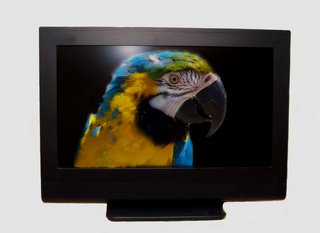As I mentioned in the first post of this series, television today seems like a “must” for most households. Since it is ever present, we become habituated to it – we don’t notice the commercials, the violence, the sexuality, and the manipulation. It’s important to take a step back and be honest about the possible effects television is having on the children in our lives.
You might expect me to say that television is inherently evil and that Montessori families need to throw out the tube. For some families, that is a solution. They simply learn to live without TV. Many of us, however, will keep the TVs and instead learn to be very choosy about what our children watch. Truthfully, some of the programming available is educational and enriching. As a tool, TV has an awing potential to bring enriching, enjoyable information right into our living rooms and classrooms.
If you would like to have a TV in your home, you need to find ways to avoid harmful programming and provide your child with such programs as will be beneficial. TV is a tool. It can be used to teach a person how to build a bomb or how to plant a daisy. The intentions of the person putting the images on the screen determine what appears. But, it is completely up to you which of those images you or your children will absorb.
Use of the TV as a Tool
 TV can help your child to absorb the experiences of a world traveler. Programs that feature fascinating cultural materials are wonderful for helping a child understand that our world is full of unique and valuable people. Animal programs are favorites, too. Learning about the amazing creatures of the rain forest or the arctic will help your child to care about these places and potentially become instrumental in protecting them.
TV can help your child to absorb the experiences of a world traveler. Programs that feature fascinating cultural materials are wonderful for helping a child understand that our world is full of unique and valuable people. Animal programs are favorites, too. Learning about the amazing creatures of the rain forest or the arctic will help your child to care about these places and potentially become instrumental in protecting them.
Some channels offer programs about gardening, home improvement, cooking or sewing. The producers of instructional programming may think they are developing materials for adult viewers, but I know two little boys who are devoted to a TV show about architecture, and can hold serious discussions with adults on the difference between a Craftsman bungalow and a Colonial mansion. Appropriately staged historical documentaries are another invaluable resource for the growing Montessori child.
You can also purchase commercial-free videos from the likes of National Geographic, Discovery or PBS. And, you can purchase entertainment-oriented TV shows or movies that were created for children and families in past decades. Shows like Little House on the Prairie or The Waltons aired before graphic violence and sexuality had become the norm, and older movies tend to follow a similar pattern.
We’re constantly hearing about how television has contributed to the rise of obesity in children. This is true; watching too much television means more calories consumed and less activity. However, I’ve just recently discovered that there are excellent children’s exercise videos available from fitness gurus like Denise Austin. Just in the past month, my kids have enjoyed Tai Bo, yoga, and pilates specifically for children. We plan on using these programs often during the winter when it’s harder to do lots of outdoor activities.
Using Good Judgment
Even when we carefully choose programs for valuable content, the reality is that few channels are commercial-free. Even PBS starts and ends each program with advertising for their sponsors. If you want your Montessori child to avoid the 20,000 annual commercial messages, your companion tool to the TV is a VCR, a DVD player, or a DVR (like Tivo). This enables you to record valuable programs for your child and fast forward the commercials.
One last thought for today: please, please do not allow your child to have a TV in their own rooms. This is statistically proven to increase both the amount of television they watch overall, as well as the amount of violence they see. Keep TVs in public places, where you can monitor both the content and the length of time spent watching. Having a television in a bedroom is a privilege, not a right, and the parent(s) should have the final say in this decision.
Interested in learning more? Check out the other two posts in this series:
Television and the Montessori Child: Part 1
This post takes a look at the ways that children are influenced by violence, sexuality, and marketing on television.
Television and the Montessori Child: Part 3
Suggestions for dealing with the effects of television at school and in the home.

